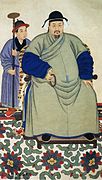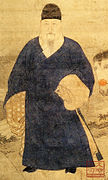Dahu (clothing): Difference between revisions
Gyuligula2 (talk | contribs) Adding short description: "A type of Chinese jacket with short sleeves or no sleeves" (Shortdesc helper) |
Citation bot (talk | contribs) Add: date, s2cid, authors 1-1. Removed parameters. Some additions/deletions were parameter name changes. | Use this bot. Report bugs. | Suggested by Abductive | #UCB_webform 2154/3824 |
||
| (15 intermediate revisions by 4 users not shown) | |||
| Line 1: | Line 1: | ||
{{Short description|A type of Chinese jacket with short sleeves or no sleeves}} |
{{Short description|A type of Chinese jacket with short sleeves or no sleeves}}{{Infobox Chinese |
||
| pic = Prince's Robe, Tomb of Ming Prince Zhu Tan (10144713634).jpg |
|||
[[File:Prince's_Robe,_Tomb_of_Ming_Prince_Zhu_Tan_(10144713634).jpg|thumb|237x237px|Ming dynasty dahu, Tomb of Prince Zhu Tan.]] |
|||
| t = 褡護 |
|||
| s = 褡护 |
|||
| p = Dāhù |
|||
| piccap = Ming dynasty dahu, unearthed from the Tomb of Prince Zhu Tan. |
|||
| hangul = 답호 |
|||
| hanja = 褡護/褡穫 |
|||
| rr = [[Dapho|Dapo]] |
|||
}} |
|||
'''Dahu (褡护) |
'''Dahu''' ({{Lang-zh|s=褡护|p=Dāhù|t=褡護}}) was a form of robe/jacket which originated in the [[Ming dynasty]].<ref name=":0">{{Cite journal|last=Wei|first=Luo|date=2018-01-02|title=A Preliminary Study of Mongol Costumes in the Ming Dynasty|url=https://doi.org/10.1080/02529203.2018.1414417|journal=Social Sciences in China|volume=39|issue=1|pages=165–185|doi=10.1080/02529203.2018.1414417|s2cid=149138176 |issn=0252-9203}}</ref> In Ming dynasty, the dahu was either a new type of [[banbi]] ({{Lang-zh|c=半臂|l=half-arm}}) or a sleeveless jacket,<ref name=":1">{{Cite web|date=2020|title=Ancient Chinese Robes for Men: Tieli & Yisan - 2020|url=https://www.newhanfu.com/6021.html|url-status=live|access-date=2021-05-24|website=www.newhanfu.com|language=en-US|archive-url=https://web.archive.org/web/20210117121223/https://www.newhanfu.com/6021.html |archive-date=2021-01-17 }}</ref><ref name=":2">{{Cite web|title=What is Da Hu - Chinese Traditional Male Clothing - 2021|url=https://www.newhanfu.com/13806.html|access-date=2021-05-24|website=www.newhanfu.com|date=16 April 2021 |language=en-US}}</ref> whose designs was influenced by the Mongol [[Fashion in Yuan dynasty|Yuan dynasty clothing]].<ref name=":0" /><ref name=":2" /> |
||
== History == |
|||
In the 21st century, the dahu, along with many forms of [[hanfu]], was revived following the [[Hanfu movement]].<ref>{{Cite web|title=Guide to Traditional Chinese Clothing - Hanfu|url=https://www.newhanfu.com/7721.html|access-date=2021-05-24|website=www.newhanfu.com|language=en-US}}</ref> |
|||
=== Yuan dynasty === |
|||
{{Main|Fashion in the Yuan dynasty}} |
|||
In the [[Yuan dynasty]], [[banbi]] were also referred as dahu in a broad sense but could also refer to a specific type of banbi of the same name, which is a half-sleeved long [[Paofu|robe]] (changpao 长袍) with a cross-collar closing to the right (''jiaoling youren 交领右衽'').<ref>{{Cite web |last=张 |first=国伟 |date=2013 |title=元代半臂的形制与渊源 |url=http://www.cqvip.com/qk/87950x/201301/45743683.html |quote=半臂又做半袖,到元代也称搭护。[...] 提出元代半臂的三种形制,即:直领短衫式半臂、交领右衽长袍式半臂(也称搭护)、方领对襟长袍式半臂}}</ref> This form of dahu (y-shaped collar long robe with short sleeves) was worn by the Mongols in the Yuan dynasty over long-sleeved robes in similar fashion as it was worn prior to the founding of the Yuan dynasty.<ref>{{Cite book |url=https://www.worldcat.org/oclc/19814728 |title=5000 years of Chinese costumes |date=1987 |publisher=China Books & Periodicals |others=Xun Zhou, Chunming Gao, 周汛, Shanghai Shi xi qu xue xiao. Zhongguo fu zhuang shi yan jiu zu |isbn=0-8351-1822-3 |location=San Francisco, CA |oclc=19814728}}</ref>{{Rp|page=142}}<ref>{{Cite book |last=Shea |first=Eiren L. |url=https://www.worldcat.org/oclc/1139920835 |title=Mongol court dress, identity formation, and global exchange |date=2020 |isbn=978-0-429-34065-9 |location=New York, NY |oclc=1139920835}}</ref>{{Rp|pages=43, 52}} |
|||
=== Ming dynasty === |
|||
In the [[Ming dynasty]], the dahu could be worn over the [[Terlig|tieli robe]] and/or could be worn under the [[Yuanlingshan|round-collar robe]].<ref name=":2" /><ref name=":1" /> Some forms of dahu was bestowed to the Joseon Kings; for example, in 1444 under the rule of King Sejong of Joseon, the Ming dynasty bestowed him dahu, along with [[Terlig|cheollik]] and [[Dragon robe|gollyeongpo]].<ref>{{Cite web |last= |title=철릭 |trans-title=Cheollik |url=https://folkency.nfm.go.kr/kr/topic/detail/7203 |access-date=2022-03-24 |website=한국민속대백과사전 |language=ko}}</ref>{{NoteTag|content=The translated English version wrote 'dopo'; however [[dopo (clothing)| dopo]] is another kind of robe. The Korean version links to the page 'dapo'. Cheollik is the equivalent of the Chinese robe Tieli. Both the Korean cheollik and Chinese tieli are derivatives of the Yuan dynasty's [[terlig]].}} In the 21st century, the dahu, along with many forms of [[hanfu]], was revived following the [[Hanfu movement]].<ref>{{Cite web |title=Guide to Traditional Chinese Clothing - Hanfu |url=https://www.newhanfu.com/7721.html |access-date=2021-05-24 |website=www.newhanfu.com |date=2 November 2020 |language=en-US}}</ref> |
|||
== Construction and design == |
== Construction and design == |
||
The dahu combined |
The dahu combined the features of the [[Tang dynasty|Tang]] and [[Song dynasty|Song dynasties]] [[hanfu]] and the [[Mongols|Mongol]] [[Yuan dynasty]] clothing.<ref name=":2" /> The dahu was a cross-collar jacket which wrapped on the right side; it could be either short-sleeves or no-sleeves.<ref name=":2" /> |
||
== |
== Gallery == |
||
<gallery mode="packed"> |
|||
File:Portrait of a man and his servant.jpg|Portrait of a man wearing dahu and his servant, 17th century. |
|||
File:徽州容像1.jpg|A man wearing a green ''dahu'', a Ming dynasty painting. |
|||
File:穿搭護男子像軸.jpg|Man wearing dahu, Ming dynasty. |
|||
</gallery> |
|||
== Similar-looking garments == |
|||
* [[Dapho]] – a Korean short sleeved overcoat.<ref name=":12">{{Cite journal|last1=Do|first1=Ju-Yeun|last2=Kwon|first2=Young-Suk|date=2001|title=Costume Images of the Chosun Period′s Po for Men(Part I ) - Constituent factors, Type, Reflection of the Period -|url=https://www.koreascience.or.kr/article/JAKO200111920988119.page|journal=Journal of the Korean Society of Clothing and Textiles|volume=25|issue=10|pages=1695–1706|issn=1225-1151}}</ref> |
|||
* [[Banbi]] |
* [[Banbi]] |
||
== See also == |
|||
* [[Fashion in Yuan dynasty]] |
* [[Fashion in Yuan dynasty]] |
||
* [[Hanfu]] |
* [[Hanfu]] |
||
* [[Terlig]] |
* [[Terlig]] |
||
== Notes == |
|||
{{Reflist|group=note}} |
|||
== References == |
== References == |
||
| Line 20: | Line 48: | ||
{{Types of Han Chinese clothing}}{{China-stub}} |
{{Types of Han Chinese clothing}}{{China-stub}} |
||
[[Category:Chinese clothing]] |
[[Category:Chinese traditional clothing]] |
||
[[Category:Han Chinese|Clothing]] |
|||
Latest revision as of 00:26, 21 September 2023
| Dahu | |||||||
|---|---|---|---|---|---|---|---|
 Ming dynasty dahu, unearthed from the Tomb of Prince Zhu Tan. | |||||||
| Chinese name | |||||||
| Traditional Chinese | 褡護 | ||||||
| Simplified Chinese | 褡护 | ||||||
| |||||||
| Korean name | |||||||
| Hangul | 답호 | ||||||
| Hanja | 褡護/褡穫 | ||||||
| |||||||
Dahu (simplified Chinese: 褡护; traditional Chinese: 褡護; pinyin: Dāhù) was a form of robe/jacket which originated in the Ming dynasty.[1] In Ming dynasty, the dahu was either a new type of banbi (Chinese: 半臂; lit. 'half-arm') or a sleeveless jacket,[2][3] whose designs was influenced by the Mongol Yuan dynasty clothing.[1][3]
History
[edit]Yuan dynasty
[edit]In the Yuan dynasty, banbi were also referred as dahu in a broad sense but could also refer to a specific type of banbi of the same name, which is a half-sleeved long robe (changpao 长袍) with a cross-collar closing to the right (jiaoling youren 交领右衽).[4] This form of dahu (y-shaped collar long robe with short sleeves) was worn by the Mongols in the Yuan dynasty over long-sleeved robes in similar fashion as it was worn prior to the founding of the Yuan dynasty.[5]: 142 [6]: 43, 52
Ming dynasty
[edit]In the Ming dynasty, the dahu could be worn over the tieli robe and/or could be worn under the round-collar robe.[3][2] Some forms of dahu was bestowed to the Joseon Kings; for example, in 1444 under the rule of King Sejong of Joseon, the Ming dynasty bestowed him dahu, along with cheollik and gollyeongpo.[7][note 1] In the 21st century, the dahu, along with many forms of hanfu, was revived following the Hanfu movement.[8]
Construction and design
[edit]The dahu combined the features of the Tang and Song dynasties hanfu and the Mongol Yuan dynasty clothing.[3] The dahu was a cross-collar jacket which wrapped on the right side; it could be either short-sleeves or no-sleeves.[3]
Gallery
[edit]-
Portrait of a man wearing dahu and his servant, 17th century.
-
A man wearing a green dahu, a Ming dynasty painting.
-
Man wearing dahu, Ming dynasty.
Similar-looking garments
[edit]See also
[edit]Notes
[edit]References
[edit]- ^ a b Wei, Luo (2018-01-02). "A Preliminary Study of Mongol Costumes in the Ming Dynasty". Social Sciences in China. 39 (1): 165–185. doi:10.1080/02529203.2018.1414417. ISSN 0252-9203. S2CID 149138176.
- ^ a b "Ancient Chinese Robes for Men: Tieli & Yisan - 2020". www.newhanfu.com. 2020. Archived from the original on 2021-01-17. Retrieved 2021-05-24.
- ^ a b c d e "What is Da Hu - Chinese Traditional Male Clothing - 2021". www.newhanfu.com. 16 April 2021. Retrieved 2021-05-24.
- ^ 张, 国伟 (2013). "元代半臂的形制与渊源".
半臂又做半袖,到元代也称搭护。[...] 提出元代半臂的三种形制,即:直领短衫式半臂、交领右衽长袍式半臂(也称搭护)、方领对襟长袍式半臂
- ^ 5000 years of Chinese costumes. Xun Zhou, Chunming Gao, 周汛, Shanghai Shi xi qu xue xiao. Zhongguo fu zhuang shi yan jiu zu. San Francisco, CA: China Books & Periodicals. 1987. ISBN 0-8351-1822-3. OCLC 19814728.
{{cite book}}: CS1 maint: others (link) - ^ Shea, Eiren L. (2020). Mongol court dress, identity formation, and global exchange. New York, NY. ISBN 978-0-429-34065-9. OCLC 1139920835.
{{cite book}}: CS1 maint: location missing publisher (link) - ^ "철릭" [Cheollik]. 한국민속대백과사전 (in Korean). Retrieved 2022-03-24.
- ^ "Guide to Traditional Chinese Clothing - Hanfu". www.newhanfu.com. 2 November 2020. Retrieved 2021-05-24.
- ^ Do, Ju-Yeun; Kwon, Young-Suk (2001). "Costume Images of the Chosun Period′s Po for Men(Part I ) - Constituent factors, Type, Reflection of the Period -". Journal of the Korean Society of Clothing and Textiles. 25 (10): 1695–1706. ISSN 1225-1151.



